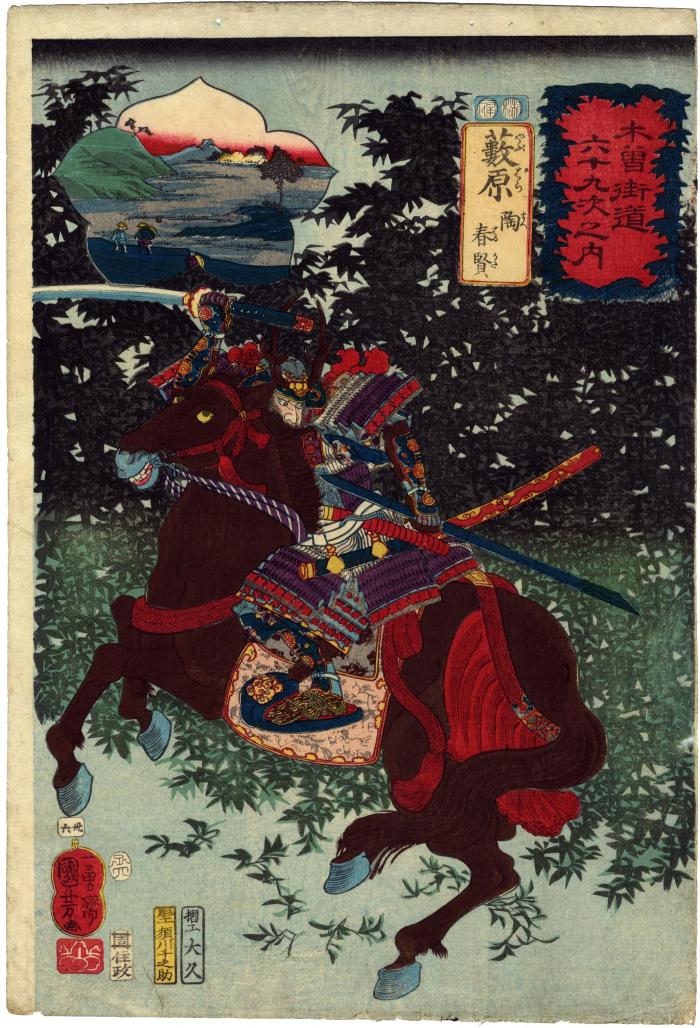Utagawa Kuniyoshi (歌川国芳) (artist 11/15/1797 – 03/05/1861)
Yabuhara (薮原): #36, Sue Harukata (陶晴賢) from the series Sixty-nine Stations of the Kisokaidō Road (Kisokaidō rokujūkyū tsugi no uchi - 木曾街道六十九次之内)
06/1852
10.25 in x 15 in (Overall dimensions) Japanese woodblock print
Signed: Ichiyūsai Kuniyoshi ga
一勇斎国芳画
Publisher: Sumiyoshiya Masagorō
(Marks 498)
Carver: Hori Sennosuke (彫工須川千之助)
Printer: Suri Ōhisa
Date: 6/1852
Censor seals: Fuku and Muramatsu
Number 36
Waseda University
British Museum
Museum of Fine Arts, Boston
Tokyo Metropolitan Library
Google maps - now located in Kiso village in Nagano Prefecture
Hiroshige Museum of Art
Musée Cernuschi
Östasiatiska Museet, Stockholm
Allen Memorial Art Museum, Oberlin College "A mounted samurai brandishes his sword with his right hand, while holding in his left hand a bamboo spear that he has apparently either just cut from the bamboo grove behind him, or perhaps snatched from the hands of an attacker. The place-name Yabuhara means literally 'thicket plain,' suggesting the bamboo thicket, and bamboo makes up the series title border.
According to the subtitle, the warrior is Sue Harukata, a powerful lord in western Japan during the troubled times of the sixteenth century. In 1551 Harukata attacked his own overlord. Ōuchi Yoshitaka (who committed suicide), and gained brief control of the Suō domain until he himself was overthrown in turn. However, no major events in Sue Harukata's life took place in a bamboo grove.
The real subject of the print is Akechi Mitsuhide, who in 1582 overthrew his lord, Oda Nobunaga, and became the de facto ruler of Japan for three days before he was defeated by Toyotomi Hideyoshi, Nobunaga's successor. The name of Sue Harukata, whose story parallels that of Mitsuhide in its basic outlines, was substituted because, under the censorship regulations of the Edo period, it was forbidden to mention any high-ranking person who had lived after 1573. An important clue is the shape of the inset landscape: a bellflower (kikyō), the personal crest of Akechi Mitsuhide. The scene depicted is Mitsuhide's last battle. On the run after his defeat by Hideyoshi, the three-day ruler of Japan was attacked at the village of Ogurusu by a group of peasants who killed him with their homemade bamboo spears.
Kuniyoshi left an even more blatant clue to the correct identification of this print on the title page published several months later, in which the subject listed under Yabuhara is not 'Sue Harukata' but rather 'Ogurusu.' "
Illustrated in and quoted from: Utagawa Kuniyoshi: The Sixty-nine Stations of the Kisokaidō by Sarah E. Thompson, Pomegranate Communications, Inc., 2009, pages 88-89, no. 36.
****
The Historical Sue Harukata 陶晴賢
"Vassal of Ōuchi Yoshitaka, daimyō of Yamaguchi (Suwō). This daimyō, having received into his castle many kuge, who had been expelled from the capital, devoted his time to literature and amusements in vogue at Court, but neglected military exercises and the administration of his provinces. His principal kerai, Mōri, Sue, Sugi, Naitō, complained to him about it, but in vain. In 1550, Harukata left Yamguchi returning to his domains; he gathered some troops in his castles of Tomita and Wakayama, and prepared to rise against his lord. The following year, he even attacked Yoshitaka and stormed Yamaguchi: Yoshitaka fled to Fukawa (Nagato), where he ws soon besieged by the rebel and killed himself. Harukata then chose a successor in the person of the brother of Ōtomo Sōrin, who took the name of Ōuchi Yoshinaga and allowed his protector to rule as he pleased. Some vassals leagued against him but Harukata at once besieged Sagara Taketō in his castle of Hanao and having taken him prisoner, put him to death, but being in turn attacked by Mōri Motonari, he was defeated and killed at Itsukushima (1555)."
Quoted from: Historical and Geographical Dictionary of Japan by E. Papinot, pp. 603-604.
****
Listed, but unillustrated, in Japanese Woodblock Prints: A Catalogue of the Mary A. Ainsworth Collection, by Roger Keyes, p. 192, #523.
****
This displays Marks seal 21-062.
warrior prints (musha-e - 武者絵) (genre)
Historical - Social - Ephemera (genre)
mitate-e (見立て絵) (genre)
Sumiyoshiya Masagorō (住吉屋政吾郎) (publisher)
